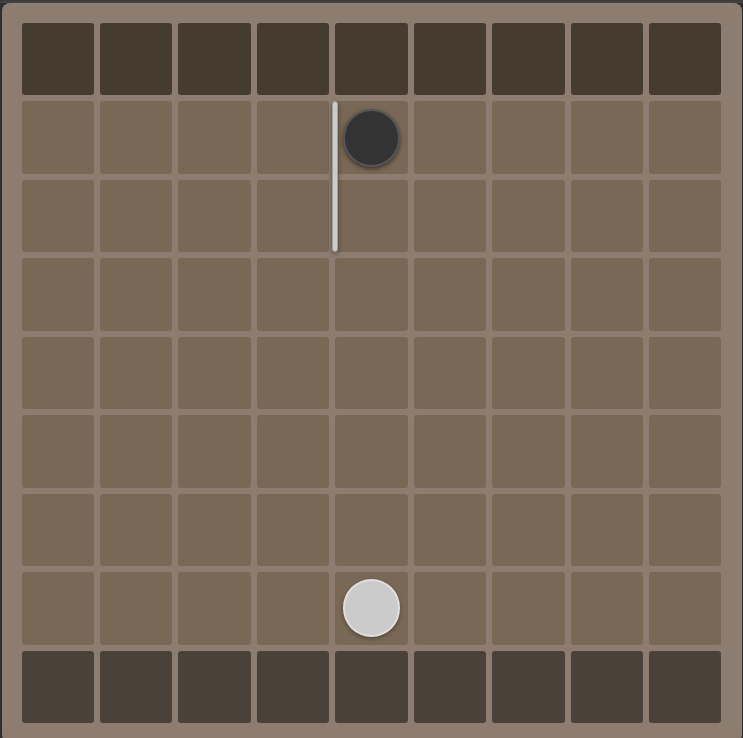Flexible: The Sidewall
'The Sidewall' is a subtle and flexible opening. Unlike direct strategies that focus on the center, the Sidewall aims to create an imbalance from the very first move, forcing the game into a more complex, tactical battle. It's a strategy of patience, waiting to see how the opponent reacts before committing to a long-term plan.
How to Play 'The Sidewall'

Step 1: The Opening Wall
The first move is a vertical wall placed to the side of the opponent's pawn. This doesn't immediately block them, but it discourages them from moving to that side of the board and begins to establish your control over that flank.
Step 2: React and Adapt
After your first wall, you wait. Your next move depends entirely on what your opponent does.
- If they advance down the center ('The Standard' or 'Rush'), you can advance your pawn towards the side you've claimed, preparing to build a path there.
- If they challenge your sidewall by moving their pawn towards it, you can place a second wall to solidify your flank control.
- If they play passively, you can claim the center with your pawn.
The key is to remain flexible. You use the opponent's moves to decide your own best strategy.
Pros and Cons
Pros
- Highly Flexible: It doesn't lock you into one plan. You can adapt your strategy—becoming aggressive, defensive, or positional—based on the game's flow.
- Creates Imbalance: It immediately breaks the symmetry of the board, which can lead to complex and interesting tactical situations where you may have an advantage.
- Unpredictable: It can confuse opponents who are used to standard openings, forcing them out of their comfort zone.
Cons
- Indirect: The first move doesn't directly shorten your path or lengthen the opponent's. It's a long-term investment that may not pay off.
- Cedes the Center: By focusing on the side, you often allow your opponent to establish strong central control with their pawn, which is generally advantageous.
- Requires Experience: This is not a beginner's opening. Playing it well requires a good understanding of tactical nuances and the ability to react correctly to various opponent responses.
How to Counter 'The Sidewall'
Responding to the Sidewall is about seizing the initiative that the opponent has offered you.
- Take the Center: This is the most principled and strongest response. Your opponent has focused on the side, so you should advance your pawn directly down the center. This secures the shortest path and forces them to react to your central threat. You are now the one dictating the pace.
- Challenge the Sidewall Directly: A more aggressive approach is to move your pawn towards their sidewall. This immediately questions their strategy. It often leads to a complex battle for control of that flank, where wall placement becomes critical.
- Ignore and Build Elsewhere: You can simply ignore their sidewall and start building your own structure on the opposite side of the board, effectively creating a race between two different plans.
'The Sidewall'은 미묘하고 유연한 오프닝입니다. 중앙에 집중하는 직접적인 전략들과 달리, 사이드월은 첫 수부터 불균형을 만들어 게임을 더 복잡하고 전술적인 싸움으로 이끌어가는 것을 목표로 합니다. 이것은 상대방이 어떻게 반응하는지를 보고 장기적인 계획을 결정하는 인내의 전략입니다.
'The Sidewall' 플레이 방법

1단계: 첫 번째 벽
첫 수는 상대방 말의 옆쪽에 수직으로 벽을 설치하는 것입니다. 이 벽은 상대를 즉시 막지는 않지만, 그쪽으로 이동하는 것을 꺼리게 만들고 해당 측면에 대한 당신의 통제권을 확립하기 시작합니다.
2단계: 반응과 적응
첫 벽을 설치한 후에는 기다립니다. 당신의 다음 수는 전적으로 상대방이 무엇을 하느냐에 달려있습니다.
- 만약 상대가 중앙으로 전진한다면('The Standard' 또는 'Rush'), 당신은 당신이 차지한 측면으로 말을 전진시켜 그곳에 경로를 만들 준비를 할 수 있습니다.
- 만약 상대가 당신의 사이드월 쪽으로 말을 움직여 도전해온다면, 두 번째 벽을 설치하여 측면 장악력을 공고히 할 수 있습니다.
- 만약 상대가 수동적으로 플레이한다면, 당신의 말로 중앙을 차지할 수 있습니다.
핵심은 유연함을 유지하는 것입니다. 당신은 상대방의 움직임을 보고 자신의 최적의 전략을 결정합니다.
장점과 단점
장점
- 높은 유연성: 하나의 계획에 얽매이지 않습니다. 게임의 흐름에 따라 공격적, 수비적, 혹은 위치적으로 전략을 조정할 수 있습니다.
- 불균형 유도: 보드의 대칭을 즉시 깨뜨려, 당신에게 유리할 수 있는 복잡하고 흥미로운 전술적 상황을 만들어냅니다.
- 예측 불가능성: 표준적인 오프닝에 익숙한 상대를 혼란스럽게 하여, 그들이 편안하게 느끼는 영역에서 벗어나도록 강요할 수 있습니다.
단점
- 간접적임: 첫 수가 당신의 경로를 직접적으로 단축시키거나 상대의 경로를 늘리지 않습니다. 성과가 없을 수도 있는 장기적인 투자입니다.
- 중앙 장악력 포기: 측면에 집중함으로써, 종종 상대방이 자신의 말로 강력한 중앙 통제권을 확립하도록 허용하게 되며, 이는 일반적으로 유리한 위치입니다.
- 경험 요구: 초보자를 위한 오프닝이 아닙니다. 이 전략을 잘 사용하려면 전술적 뉘앙스에 대한 깊은 이해와 상대의 다양한 반응에 정확하게 대응하는 능력이 필요합니다.
'The Sidewall' 대응법
사이드월에 대응하는 것은 상대방이 당신에게 제공한 주도권을 잡는 것입니다.
- 중앙 차지: 가장 원칙적이고 강력한 대응입니다. 상대방이 측면에 집중했으므로, 당신은 말을 중앙으로 직접 전진시켜야 합니다. 이는 가장 짧은 경로를 확보하고 상대가 당신의 중앙 위협에 반응하도록 강요합니다. 이제 당신이 게임의 템포를 주도하게 됩니다.
- 사이드월에 직접 도전: 더 공격적인 접근 방식은 상대의 사이드월 쪽으로 당신의 말을 움직이는 것입니다. 이는 즉시 그들의 전략에 의문을 제기합니다. 이것은 종종 그 측면의 통제권을 둘러싼 복잡한 싸움으로 이어지며, 벽 배치가 매우 중요해집니다.
- 무시하고 다른 곳에 건설: 상대의 사이드월을 그냥 무시하고 보드 반대편에 자신만의 구조물을 만들기 시작할 수도 있으며, 이는 효과적으로 두 개의 다른 계획 사이의 경주를 만듭니다.